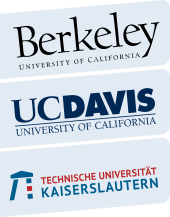

RESEARCH PROGRAM
Title: Analysis and Visualization Flow Networks Using a Flow Topology Graph
Name: Garrett Aldrich
(former student)
Project description:
Starting situation
Our project is centered on understanding flow in fractured rock such as granite, shale and marble, where fluid transport primarily occurs within the fractures of the rock. The study of fractured rock has become increasingly important in recent years, considering for example, in the long-term storage of nuclear waste, unconventional hydrocarbon acquisition, and groundwater contamination remediation. We adopt the discrete fracture network (DFN) methodology for modeling transport on fractured rock, where fractures are explicitly represented as polygons constrained in a 3D domain. A steady state flow solution is calculated on the domain and a Lagrangian approach is used to advect particles and simulate fluid transport.
Approach
A Flow Topology Graph (FTG) is used to represent the topology of fluid transport in terms of the fracture topology. From this abstraction we are able to analyze the flow primarily using three methods. First, we calculate local and global statistical distributions for particles traversing the entire DFN, subsections such as connected paths, and individual fractures. These statistics allow users to evaluate the accuracy of a model, compare between multiple realizations and understand the effect of parameter changes. Second, we extract paths from the DFN as connected sets of fractures. We are most interested in finding backbones, which are paths where channelization occurs, the process by which flow becomes trapped and concentrated. Finally, we use topological clustering to identify particles that take similar paths through the network. This allows us to more easily identify trends within the network and verify channelization on backbones described by our path finding algorithm.
Expected Results
Using the FTG-based method we have been able to evaluate several DFN from small toy examples used for illustrative purposes to large realistic models consisting of five thousand fractures constrained to a domain of one kilometer cubed. The larger DFN have been used to study both gravity driven flow for nuclear waste storage and well-driven flow for fuel and gas retrieval. We are currently interested in using our analysis method to compare multiple realizations of DFN which model the same site but consist of different fracture topologies. This is important as DFN are generated stochastically by sampling distributions defined by core samples from different sites. We are also interested in how changes in parameters and how they are modeled affect the patterns of flow.

